The dimensions of a piano bench are a crucial but often overlooked aspect of piano playing. The precise dimensions ensure utmost comfort, posture, and fluidity of movement, all of which significantly impact the player’s performance. From solo benches to duet benches, and adjustable piano stools to keyboard benches, each has its unique dimensions catering to specific needs. This document aims to elucidate the importance of piano bench dimensions, discussing various types, their dimensions, and how to choose the right one.
Profound Implications of Correct Bench Height on Piano Playing
The height of the piano bench plays a crucial role in determining the player’s level of control and precision during their performance.
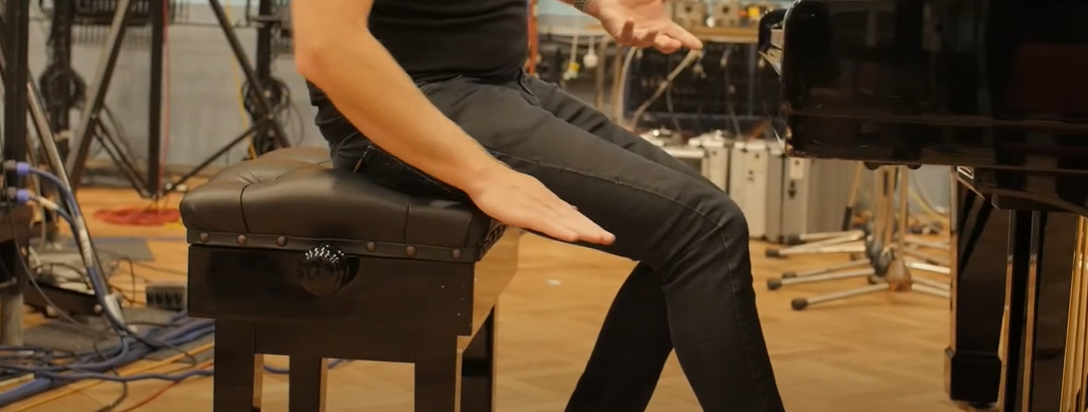
Magnifying Comfort and Minimizing Fatigue
A well-fitted piano bench can significantly enhance the comfort of the player, thus allowing them to focus more on the artistry of their performance. The right bench height supports the player’s back, reducing the strain on muscles and ligaments and minimizing fatigue during extended sessions of playing. In contrast, a bench that is too high or too low might leave the player uncomfortable, leading to postural issues and potential injury over time. Therefore, paying close attention to the bench’s dimensions, particularly its height, can greatly amplify the comfort of the player and minimize fatigue, making long practice sessions more enjoyable and productive.
Optimizing Reach and Enhancing Flexibility
The proper bench height optimizes a pianist’s reach to the keyboard, enhancing flexibility and fluidity in movement. At the suitable height, a pianist’s forearm should be parallel to the ground when their hands are on the keys, allowing the optimum range of motion. This position lets the pianist reach each key with ease, from the lowest to the highest, without any unnecessary strain on the wrist or arm. Furthermore, it facilitates nuanced control over the keys, enabling the artist to produce a broad spectrum of dynamics with precision. In essence, the correct bench dimensions help in fostering a balance between reach and flexibility, which is pivotal to a pianist’s technique and expression. [1]
Fostering the Cultivation of Proper Technique
The right bench dimensions cultivate the development of proper piano playing technique. Proper technique is key to effective piano performance, and the right bench height helps establish it. At an appropriate height, a pianist’s arm and wrist alignment support effective key striking, reducing the risk of striking the keys too harshly or too softly. A bench that is too high may lead to a downward striking motion, while one that’s too low can result in an unfavorable upward motion. The right bench height promotes a natural horizontal motion, enhancing touch and performance. The proper bench dimensions support proper technique, forming the foundation for executing complex musical pieces.
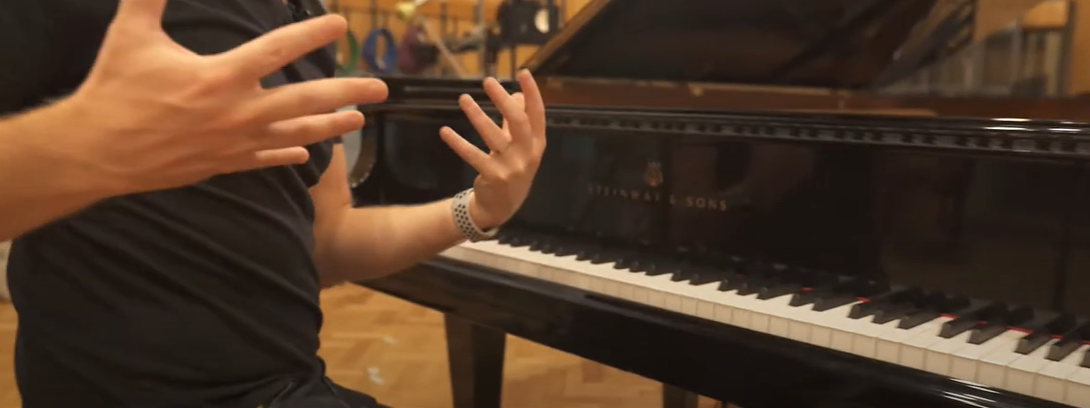
Different Types of Piano Benches
Different piano benches cater to various needs and preferences of players.
Standard Benches
Standard benches are commonly used for pianos in homes, schools, and concert halls. They are often paired with upright pianos but can be used with grand pianos as well. The standard dimensions for these benches are approximately 30 inches in width, 14 inches in depth, and about 19 inches in height. This size can comfortably accommodate one adult player. These benches are typically made of solid wood, and some models come with a storage compartment under the seat for storing sheet music or other accessories. The simplicity and functionality of standard benches make them a popular choice among pianists. [2]
Adjustable Benches
Adjustable benches are a great solution for players who need to customize the bench height for comfort and technique. These benches are designed with a mechanism that allows the seat to be raised or lowered, enabling it to cater to the height requirements of different individuals or the particular requirements of specific compositions. Adjustable benches are typically around 22 to 33 inches in width, 13 inches in depth, while their height can be adjusted roughly between 18 to 24 inches. This feature makes them ideal for concert pianists, teachers, and students, as they can be tailored to meet individual needs. Furthermore, many adjustable benches provide padding for additional comfort, and some models include storage compartments. With their versatility and comfort, adjustable benches are well-suited for both professional and home environments.
Double Benches
Double benches, also known as duet benches, are designed to comfortably accommodate two players, making them perfect for duet performances or teaching scenarios. They are significantly wider than standard or adjustable benches, measuring roughly between 33 to 38 inches in width. The depth is typically around 14 inches, while the height is generally similar to that of standard benches, approximately 19 inches. However, some models offer adjustable height features to cater to a wider range of users. Double benches are often sturdy and robust, with some models offering padding for additional comfort, and others featuring storage compartments for convenience. They are an ideal choice for music teachers, students engaged in duet practice, or any situation where two players need to use the piano simultaneously.
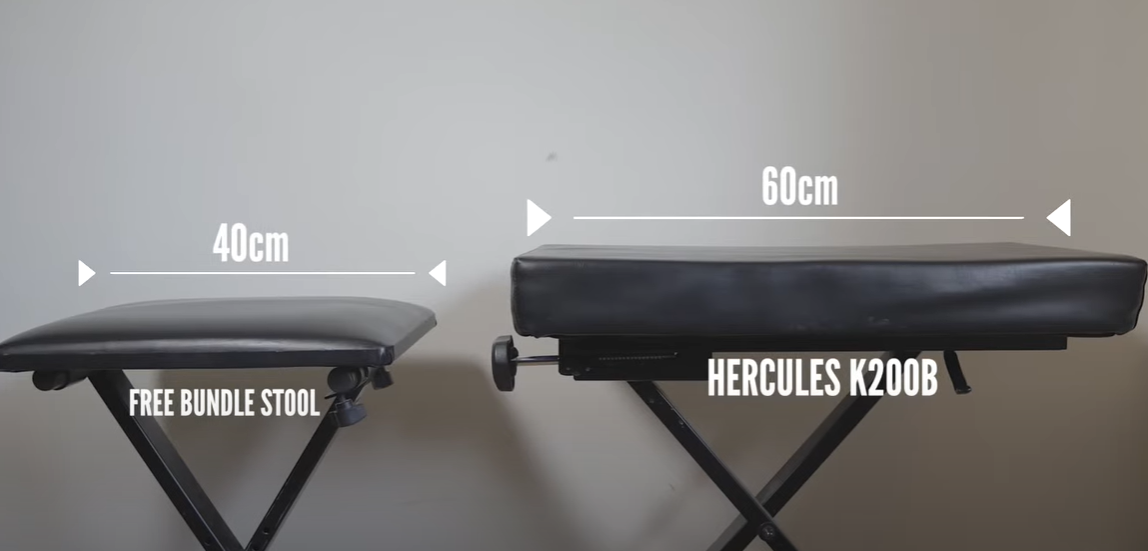
Artist Benches
Artist benches are the pinnacle of comfort and adjustability, designed primarily for professional pianists. These benches are heavily padded, providing the utmost comfort for long hours of practice or performance. Artist benches are typically between 21 to 33 inches in width and around 13 inches in depth, and their height can be adjusted approximately between 18 to 24 inches. This adjustable height feature makes these benches extremely versatile, catering to the specific needs of different pianists. Moreover, artist benches frequently include a storage compartment, offering a convenient area for keeping sheet music and various accessories. Despite being the most expensive type of piano bench, their comfort and functionality make them a preferred choice for many professional pianists. [3]
Tips for Choosing the Right Piano Bench
When selecting the perfect piano bench, it is crucial to take into account various factors:
- Comfort: Ensure that the bench provides the necessary comfort for prolonged periods of playing. A cushioned or padded bench can offer more comfort compared to a hard one. Some pianists also prefer benches with a curved seat for additional support.
- Adjustability: If multiple individuals will be using the piano, or if you play different types of compositions requiring altered seating, an adjustable bench might be a better option. It allows for height modifications to suit individual needs.
- Durability: It’s crucial to choose a bench that’s sturdy and durable, particularly if it will be used frequently. Check the bench’s build quality and the type of material used. Solid wood benches tend to be more long-lasting.
- Size: The bench size should correlate with the piano’s size and the available space. A duet bench might not be suitable for a small room, even if you need to accommodate two players.
- Storage: Certain benches are equipped with storage compartments, providing a convenient solution for keeping sheet music or other accessories neatly organized. If you have many such items, consider a bench with storage.
- Style and finish: The bench’s style and finish should complement the piano and the room’s decor. There is a wide array of finishes available for benches, providing the opportunity to select one that harmonizes aesthetically with your piano or the room it occupies.
Remember, the right bench will enhance your piano-playing experience, so it’s worth investing time and thought into this decision.
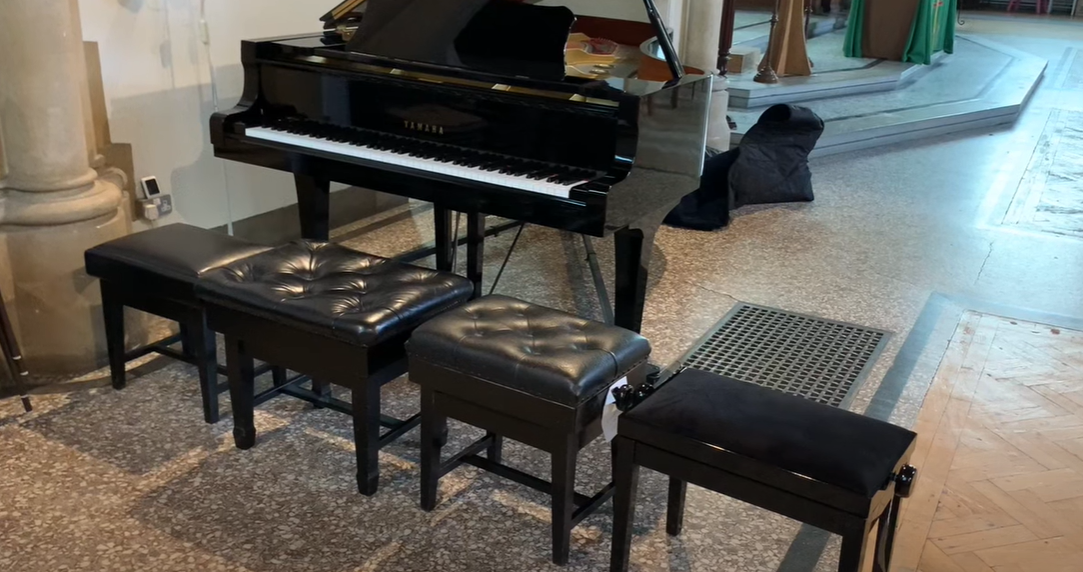
The Role of Piano Bench Cushions
Piano bench cushions play a prominent role in enhancing the comfort and aesthetics of your piano seating arrangements. Filled with foam or other plush materials, these cushions offer extra padding that greatly enhances comfort during long hours of piano playing. This is especially beneficial for musicians who spend many hours practicing or performing, as a comfortable seat can minimize fatigue and maintain focus. Moreover, the adaptability of cushions allows them to be used on any type of piano bench, be it standard, adjustable, double, or artist benches.
Beyond comfort, piano bench cushions also contribute to the aesthetics of your piano setup. They come in a wide range of colors, patterns, and fabrics, providing an opportunity to complement or contrast with the existing décor of the room. This enables pianists to add a touch of personal style to their piano bench. Some cushions are even reversible, offering two different looks in one product. Furthermore, many cushions feature ties or other fastening mechanisms that secure them to the bench, ensuring they stay in place during use. Overall, while a piano bench cushion is not a necessity, its benefits in terms of comfort and style make it a worthwhile addition for many pianists. [4]
The Intricate Relation Between Bench Height and Foot Pedal Usage
The height of a piano bench plays a crucial role in enabling the player to skillfully utilize the foot pedals of a piano, directly influencing their ability to perform effectively. An accurately adjusted bench height allows the pianist to uphold a correct posture while playing, ensuring that the feet can effortlessly reach the pedals without exerting strain on the back or legs. Too high of bench seating may cause the player’s feet to hover or strain to reach the pedals, leading to discomfort or fatigue over time. Conversely, a bench set too low may impede clear visibility of the keyboard and result in an awkward downward angle for the hands and wrists, in addition to making pedaling difficult.
The complex interplay between bench height and foot pedal usage highlights the significance of selecting an adjustable bench or one with the appropriate height for the player. This ensures the pianist is equipped to fully utilize the expressive potential of the piano pedals, while also maintaining comfort and proper posture.
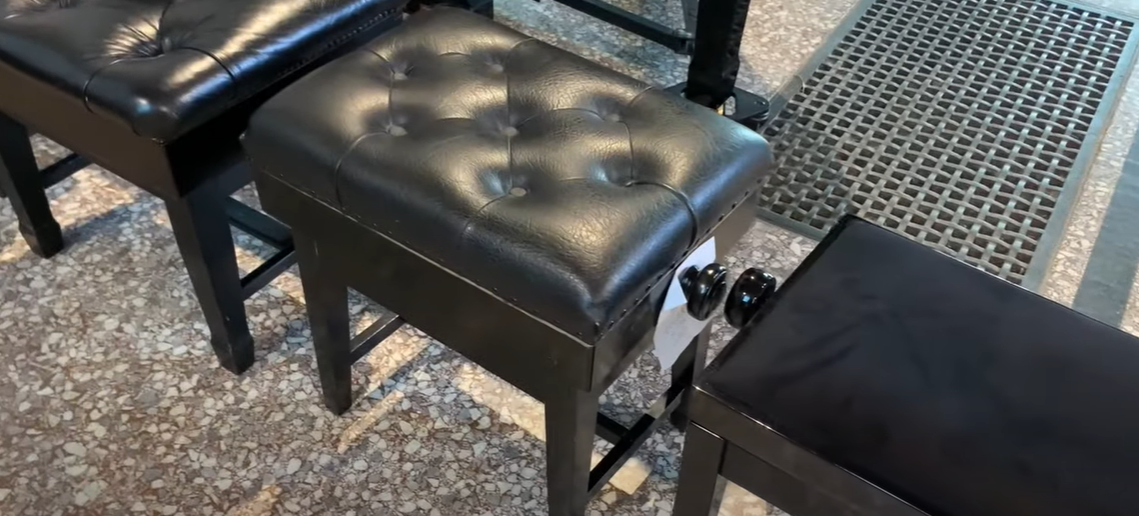
Strategies to Cope if Your Bench Height Isn’t Adjustable
If your piano bench height is not adjustable, there are still various techniques you can employ to guarantee a comfortable and effective playing experience.
- Use a cushion or a folded blanket: Placing a cushion or a folded blanket on top of the bench can help raise the seat height. This is a simple and cost-effective way to make adjustments. Keep in mind that the cushion or blanket should be firm enough to support your weight without sinking too much.
- Footrest: If the bench is too high and your feet can’t comfortably reach the floor or the pedals, consider using a footrest. This can help provide the necessary support for your feet and improve your playing posture.
- Non-skid pads: To prevent the cushion or footrest from slipping, you can use non-skid pads. They can keep your makeshift solutions steady, contributing to a safer and more comfortable playing experience.
- Replace the bench: If none of these solutions are effective, you might need to consider replacing your bench with one that better fits your height or is adjustable. This can be a more expensive option, but it could be a worthwhile investment for your comfort and performance. [5]
Remember, the goal is to achieve a comfortable playing position where your feet can reach the pedals, your arms are at the right angle to the keyboard, and your back is straight. Different individuals may find that various solutions suit them best, so it may require some experimentation to discover the optimal approach for you.
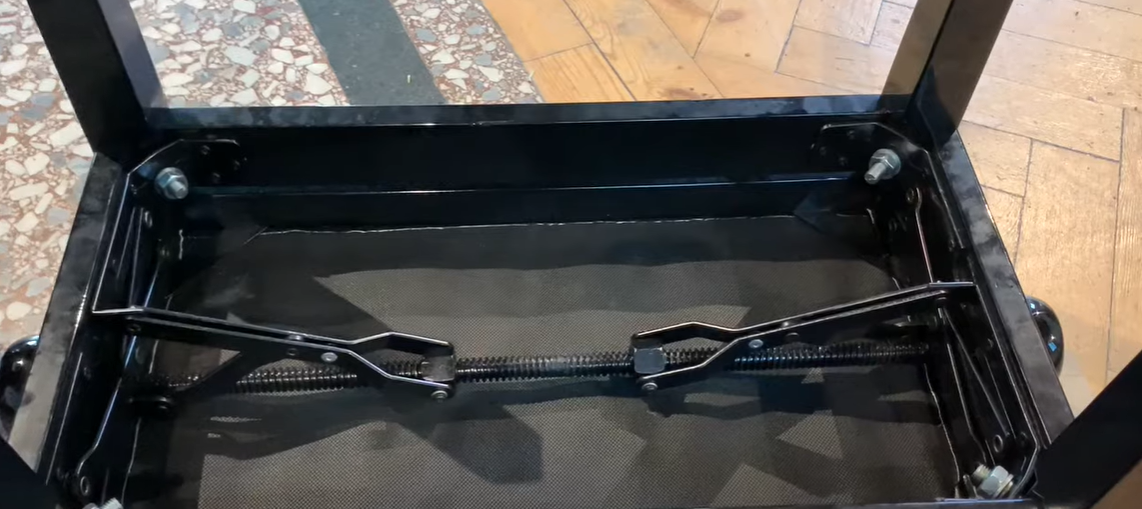
FAQ
What is the perfect height for a piano bench?
The optimal height of a piano bench is subjective and varies based on the pianist’s height and individual comfort preferences. However, a general rule of thumb is that the bench should be at such a height that the pianist’s forearms are level or slightly sloping downwards towards the keys when they’re sitting upright and the elbows are slightly above the level of the keys. This typically translates to a bench height of about 19 to 21 inches for most adults. For children or shorter individuals, a lower bench or an adjustable bench can be beneficial. It is recommended to experiment with various heights to discover the most comfortable position that provides optimal control over the keys and pedals.
What size is a Yamaha bench?
A standard Yamaha piano bench usually measures about 24 inches long, 13.5 inches wide, and approximately 19.5 inches tall. However, the dimensions may vary slightly depending on the particular model and type of bench being used. It’s always advisable to check the specifications provided by Yamaha for the particular bench in question to ensure accurate measurements. Remember, the ideal bench size should provide sufficient space for you to comfortably sit and move while playing, and the height should allow for correct posture and effective use of the piano’s keys and pedals.
Why are piano benches so expensive?
Piano benches are often seen as pricey due to high-quality materials, craftsmanship, and their specialized use. A well-made piano bench is usually crafted from durable, high-quality materials like hardwood, which is more expensive than other common furniture materials. The craftsmanship that goes into creating a piano bench also contributes to its price. Many benches are handcrafted, requiring a significant amount of time and skill to produce. Adjustability features, padding, and the finish can also add to the cost. Moreover, piano benches are a niche product, specifically designed for use with pianos. This specialized use can drive up the price, as they are not mass-produced to the same extent as regular chairs or benches. It’s worth noting that investing in a high-quality piano bench can enhance comfort, posture, and ultimately, the pianist’s performance.
How much space do I need for a piano?
The space required for a piano can vary greatly depending on the type of piano. Upright pianos, which are more compact, generally require a space of about 5 feet wide and 2 to 2.5 feet deep. In contrast, grand pianos necessitate a significantly more spacious area owing to their distinctive shape and considerable size. A compact grand piano typically requires around 5 feet by 6 feet of space, whereas a concert grand piano may necessitate up to 9 feet by 5 feet. In addition to the space for the piano itself, you should also account for the bench and the pianist’s movement, which would need an additional 3 feet. Moreover, consider room for the lid to open on a grand piano, as well as enough space for sound to flow freely and acoustics to develop. Remember that these dimensions are approximate, and it is always best to measure your specific piano and room before making a decision.
What is the size of a piano in CM?
The size of a piano can greatly vary between different types and models. Upright pianos, also known as vertical pianos, are typically about 150 cm wide, 60 cm deep, and range in height from 100 cm to 130 cm. Grand pianos, on the other hand, have a much larger footprint. Baby grand pianos typically have a width of approximately 150 cm and a length ranging from 150 cm to 180 cm. Concert grand pianos, the largest type, can be as big as 100 cm in height, 150 cm in width, and 275 cm in length. Remember, these are standard measurements and can vary based on the specific brand or model. Always check the dimensions of your specific piano for the most accurate measurements. So, the size of a piano bench would vary depending on the type and model of the piano. However, a standard piano bench is usually around 24 inches in length, 13.5 inches in width, and approximately 19.5 inches in height.
How wide is a piano stool?
A typical piano stool is usually around 14 to 16 inches in width. However, the width of a piano stool can vary depending on the style and design of the stool. Adjustable piano stools, duet stools, or stools that come with a storage compartment may be wider. It is always important to verify the dimensions provided by the manufacturer to ensure it matches your requirements. A piano stool should be wide enough to allow the pianist to sit comfortably and move freely while playing. It is equally important to take into account the width of the piano bench about the piano itself. An excessively wide stool can occupy unnecessary space or fail to fit properly. Ultimately, it’s best to test out different stool sizes and styles to find what works best for you and your playing needs. Overall, when considering piano bench dimensions, remember that comfort, posture, and effective use of the piano are key factors. The optimal size may differ based on personal preferences, but by carefully measuring and experimenting with various choices, one can discover the ideal fit for a truly enjoyable and comfortable playing experience.
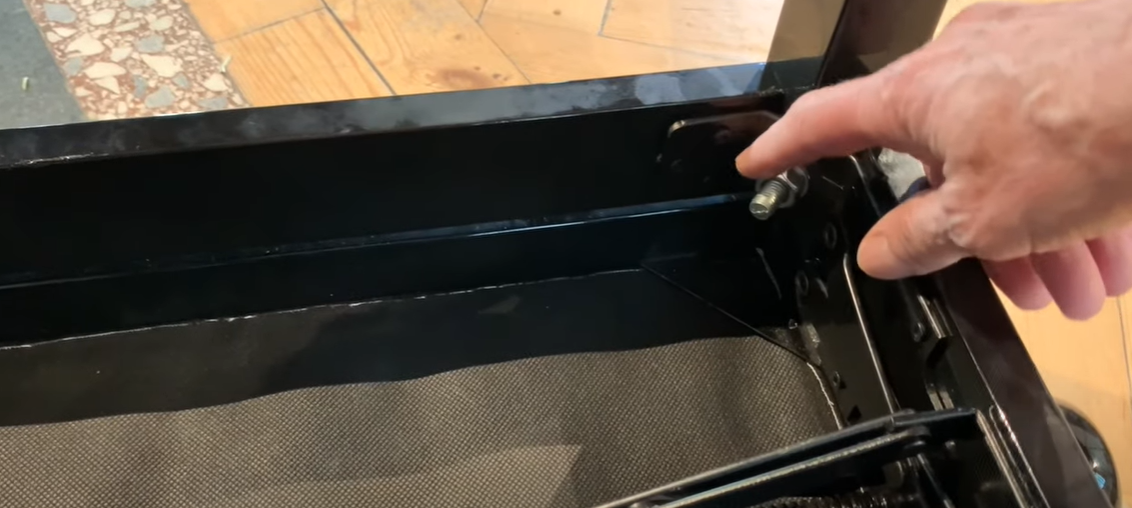
What is the height of a piano bench for a child?
The optimal height of a piano bench for a child may differ based on their height, age, and comfort level while playing the piano. However, a common recommendation is a height of around 14 to 15 inches. This height allows most children to comfortably reach the piano keys and pedals, while also maintaining good posture. It’s worth noting that an adjustable piano bench can be a great investment for a child, as it can grow with them and be adjusted to maintain the correct height over time. Always remember, that comfort and proper posture are essential when playing the piano, so it may be beneficial to try out different bench heights to find the one that is most comfortable for the child.
What makes a good piano bench?
A good piano bench combines comfort, durability, and adjustability. Comfort is paramount; a bench with adequate padding ensures that the pianist can sit for extended periods without discomfort. The material of the padding also matters, with leather or high-quality vinyl being preferred for their durability and feel. Durability is another important factor. A good bench is typically made from solid, hard-wearing materials like hardwood, ensuring it can withstand regular use over time. A sturdy bench also provides stability while playing, enhancing the pianist’s performance. Adjustability is crucial, especially for multiple users or for children who are growing. An adjustable bench allows for the height to be changed to suit the pianist, promoting proper posture and ease of playing. Certain benches also provide storage compartments, which can be quite handy for keeping sheet music or other accessories. Lastly, the aesthetic appeal of the bench should not be overlooked. A well-crafted, beautiful bench not only functions well but also adds to the overall aesthetic of the room.
What is a piano bench called?
A piano bench is commonly known as a “piano bench” or “piano stool”. These terms are often used interchangeably, though some may argue that a “stool” usually refers to a seat without a backrest, while a “bench” might suggest a larger, more substantial seat that could accommodate more than one person. In some contexts, it might also be referred to as a “piano chair”. However, the most commonly used term is “piano bench”. The name chosen can ultimately differ based on personal preference or regional dialect. Overall, the purpose of a piano bench remains the same – to provide a comfortable and stable seat for playing the instrument. Whether it’s called a bench or stool, finding one that meets all of your needs is crucial for enjoying your piano playing experience to its fullest potential. So, when looking for a piano bench, make sure to consider factors like size, comfort, adjustability, and durability to find the perfect fit for you and your instrument.
Useful Video: How High Should A Piano Bench Be
Conclusion
In summary, the selection of a piano bench holds equal importance to that of choosing the piano itself. Proper dimensions are crucial to ensure the bench perfectly complements the piano in terms of size and functionality. A typical piano bench measures about 24 inches in length and 13.5 inches in width, with a height of approximately 19.5 inches for adults. For children, the recommended height is around 14 to 15 inches. It’s crucial to bear in mind that these measurements can vary based on the type of bench, its design, and the specific requirements of the pianist. Besides dimensions, comfort, durability, adjustability, and aesthetic appeal are also key factors to consider when choosing a piano bench. Whether it’s called a piano bench, stool, or chair, this piece of furniture is integral to a pianist’s performance and overall playing experience.
References:
- https://hidraupianobenches.com/piano-benches-everything-you-need-to-know/#:~:text=Grand%20piano%20benches%20usually%20have,wide%20and%2019%20inches%20high.
- https://coltharppianoworld.com/what-you-should-know-about-piano-benches/
- https://primesound.org/piano-bench-height/
- https://digitalpianothebest.com/how-tall-is-a-piano-bench/#google_vignette
- https://teds-list.com/tutorial/how-tall-should-a-piano-bench-be/#google_vignette





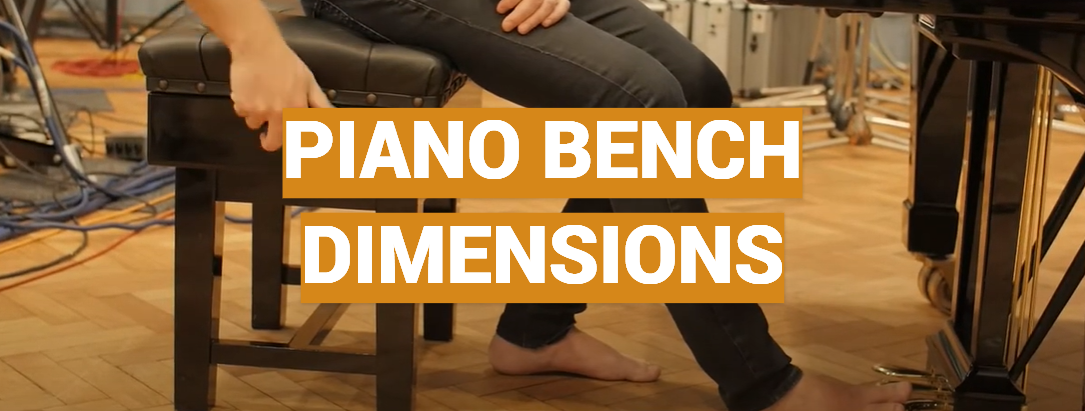




Leave a Reply